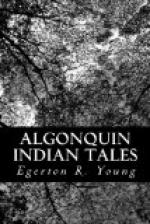“But what about his dinner?” asked the kind-hearted Minnehaha. “If we keep him here telling stories he will be too late to get back to his wigwam for his dinner. I think we had better take him home with us.”
This was quickly decided upon, and that there might be no mistake a piece of bark was quickly cut from a birch tree and a few lines written upon it telling the good mother in the home that they had met Souwanas, and that he was entertaining the children with Nanahboozhoo stories and would be with them to dinner. Then Jack, the great dog, was called and sent back with the missive, with orders to give it to his mistress.
As the dog dashed away homeward the mischievous Sagastao said:
“My! don’t I wish I was in the kitchen when Mary hears that we are out here with Souwanas listening to stories about Nanahboozhoo! Won’t she be hopping mad!”
“It will be better,” said his father, “for Souwanas to tell his story than for you to make any further remarks of that kind.”
At first Souwanas seemed to show some hesitancy in beginning his story in the presence of his missionary, and he whispered to Sagastao his fears that perhaps his father would not care for such trifles as Indian legends and stories.
With his usual bluntness, the lad declared:
“O, you don’t know our father if you think that way about him. He loves nice stories as well as we do, and tells us lots of them; so go ahead, for you are going home to dinner with us.”
Thus assured, the old man began:
“I will tell you to-day about how it is that the rabbits are white in winter.
“Long ago they were always brown, just like those that are lying there with the ducks. It is true that they increase very fast, but then it is very true that they have many enemies. They have not many ways to defend themselves against their foes, who are of so many kinds. Almost all the animals that live on flesh are always hunting for rabbits, and so are the foxes of all kinds, the wild cats, wolves, and wolverines, and even the little weasels and ermine. Then there are fierce birds—the eagle, the hawks of all kinds and the owls—that are always on the lookout for rabbits, young or old.
“The result was that with this war continually being waged against them the poor rabbits had a hard time of it, and especially in winter; for they found it very difficult to hide themselves when the leaves were off the trees and the ground covered with snow. In those days in the long ago the animals used to have a great council. There the great fathers or heads of each kind of animal and bird used to meet together and talk about their welfare and the welfare of each other. Then there was peace and friendship among them while at the council.
“They appointed a king, and he presided as a great head chief. All the animals that had troubles or grievances had a right to come and speak about them and, if possible, have them remedied.




